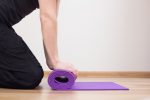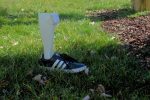Through Exercise, I’m Confronting My Specific CMT Weaknesses
Written by |

With great effort, a woman pulls herself up from a wheelchair and into the back seat of a car. Her body is weak, and she can’t seem to move her legs. She wasn’t always like this, though, unable to walk and barely able to fight.
No, she was once a member of a team of elite assassins. That is, until those closest to her betrayed her and tried to murder her. Although she survived, her would-be killers gravely injured her, and her life hasn’t been the same since.
In the back seat, she props herself up. Looking at her feet, she voices a command to her body, as if it’s not her own.
“Wiggle your big toe,” she says.
She can’t accept her body in its current state. She needs to regain her strength and mobility. After all, she has to exact her revenge. And for that, she needs a body that can fight and kill her many enemies.
But first, she must be able to wiggle a toe.
This scene from the movie “Kill Bill: Vol. 1” came to my mind recently. It’s not because I’m out for revenge. I have no score to settle, no enemies I feel compelled to see destroyed.
However, I’ve recently been trying to do exercises with more focus on the tiny movements that I find difficult to perform due to symptoms of Charcot-Marie-Tooth disease (CMT).
As such, I often feel a bit like that character in that scene, willing the stubborn parts of my body to move even just a quarter of an inch more.
“C’mon, ankle, I need you to move just a tad farther,” I think as I try to perform physical therapy exercises, many of which I haven’t attempted in almost two decades.
It’s not as if I haven’t exercised at all since my childhood time in physical therapy. But until a couple months ago, I’d been more focused on exercises that I considered traditional, conventional.
“Pick this up.” “Set this down.” “Make this wheel spin.” These actions have largely made up my workout routines whenever I muster up the motivation to go to the gym. And I still believe such exercises and movements are helpful, useful, and important for me to practice.
But perhaps I had for too long overlooked the small movements, the ones that force me to confront the parts of my CMT body that often give me grief.
This changed for me about a month ago when I went to a consultation with an orthotist to explore the option of getting my legs back into ankle-foot orthoses (AFOs). It’s a prospect I’m actually somewhat excited about. I could use the extra support and balance good AFOs offer.
However, the orthotist encouraged me to remember that while AFOs do indeed have a lot to offer, even the best ones can possibly be a double-edged sword. Because AFOs restrict a lot of ankle and foot movement, some muscles never get used when wearing AFOs. As such, extended use of AFOs can, in some cases, cause even more atrophy.
I’d like to avoid that if possible.
So, I’m recalibrating my workout routine yet again. I’m back to doing some of the same physical therapy exercises from my childhood — exercises I probably shouldn’t have neglected for so long.
“Movement is medicine” is a popular mantra in the CMT community.
However, I’m remembering that just like medicine, there are times when a more focused and targeted approach is important. Physical therapists, personal trainers, and other CMTers can help a lot. They’ve certainly helped me during my childhood and more recently. With additional practice and continued exercise, I hope to feel a bit stronger and more ready to get back into AFOs.
Every body is different. Every CMTer is different. In preparing for a possible reintroduction of AFOs into my life, I’ve been working on a lot of small and focused movements — particularly in my ankles and calves. Others may need to focus on the bigger movements.
Although it’s not a perfect substitute for personalized physical therapy, for those interested, there are at least a few opportunities coming up to connect with other CMTers and talk about the benefits of movement and exercise.
The Charcot-Marie-Tooth Association has an upcoming virtual meeting with Julie Barnett, a CMTer and personal trainer. And the Hereditary Neuropathy Foundation has two virtual workouts on the calendar this September with Julie Stone, a CMTer and fitness instructor.
***
Note: Charcot-Marie-Tooth News is strictly a news and information website about the disease. It does not provide medical advice, diagnosis, or treatment. This content is not intended to be a substitute for professional medical advice, diagnosis, or treatment. Always seek the advice of your physician or other qualified health provider with any questions you may have regarding a medical condition. Never disregard professional medical advice or delay in seeking it because of something you have read on this website. The opinions expressed in this column are not those of Charcot-Marie-Tooth News or its parent company, Bionews Services, and are intended to spark discussion about issues pertaining to Charcot-Marie-Tooth.







Leave a comment
Fill in the required fields to post. Your email address will not be published.